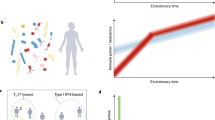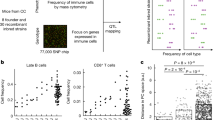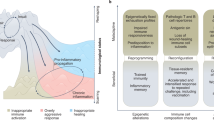Abstract
Detailed population-level description of the human immune system has recently become achievable. We used a 'systems-level' approach to establish a resource of cellular immune profiles of 670 healthy individuals. We report a high level of interindividual variation, with low longitudinal variation, at the level of cellular subset composition of the immune system. Despite the profound effects of antigen exposure on individual antigen-specific clones, the cellular subset structure proved highly elastic, with transient vaccination-induced changes followed by a return to the individual's unique baseline. Notably, the largest influence on immunological variation identified was cohabitation, with 50% less immunological variation between individuals who share an environment (as parents) than between people in the wider population. These results identify local environmental conditions as a key factor in shaping the human immune system.
This is a preview of subscription content, access via your institution
Access options
Subscribe to this journal
Receive 12 print issues and online access
$209.00 per year
only $17.42 per issue
Buy this article
- Purchase on SpringerLink
- Instant access to full article PDF
Prices may be subject to local taxes which are calculated during checkout






Similar content being viewed by others
Change history
25 November 2020
An amendment to this paper has been published and can be accessed via a link at the top of the paper.
References
Davis, M.M. Immunology taught by humans. Sci. Transl. Med.4, 117fs2 (2012).
Orrù, V. et al. Genetic variants regulating immune cell levels in health and disease. Cell155, 242–256 (2013).
Brodin, P. et al. Variation in the human immune system is largely driven by non-heritable influences. Cell160, 37–47 (2015).
De Jager, P.L. et al. ImmVar project: Insights and design considerations for future studies of “healthy” immune variation. Semin. Immunol.27, 51–57 (2015).
Shaw, A.C., Goldstein, D.R. & Montgomery, R.R. Age-dependent dysregulation of innate immunity. Nat. Rev. Immunol.13, 875–887 (2013).
Jamieson, B.D. et al. Generation of functional thymocytes in the human adult. Immunity10, 569–575 (1999).
den Braber, I. et al. Maintenance of peripheral naive T cells is sustained by thymus output in mice but not humans. Immunity36, 288–297 (2012).
Johnson, P.L., Yates, A.J., Goronzy, J.J. & Antia, R. Peripheral selection rather than thymic involution explains sudden contraction in naive CD4 T-cell diversity with age. Proc. Natl. Acad. Sci. USA109, 21432–21437 (2012).
Tsang, J.S. et al. Global analyses of human immune variation reveal baseline predictors of postvaccination responses. Cell157, 499–513 (2014).
Caballero, S. & Pamer, E.G. Microbiota-mediated inflammation and antimicrobial defense in the intestine. Annu. Rev. Immunol.33, 227–256 (2015).
Ivanov, I.I. et al. Induction of intestinal Th17 cells by segmented filamentous bacteria. Cell139, 485–498 (2009).
Tsang, J.S. et al. Global analyses of human immune variation reveal baseline predictors of postvaccination responses. Cell157, 499–513 (2014).
Lucas, M. et al. Ex vivo phenotype and frequency of influenza virus-specific CD4 memory T cells. J. Virol.78, 7284–7287 (2004).
Miller, J.D. et al. Human effector and memory CD8+ T cell responses to smallpox and yellow fever vaccines. Immunity28, 710–722 (2008).
Bucasas, K.L. et al. Early patterns of gene expression correlate with the humoral immune response to influenza vaccination in humans. J. Infect. Dis.203, 921–929 (2011).
Nakaya, H.I. et al. Systems biology of vaccination for seasonal influenza in humans. Nat. Immunol.12, 786–795 (2011).
Amadori, A. et al. Genetic control of the CD4/CD8 T-cell ratio in humans. Nat. Med.1, 1279–1283 (1995).
Spiegelman, B.M. & Hotamisligil, G.S. Through thick and thin: wasting, obesity, and TNF-α. Cell73, 625–627 (1993).
Spielmann, G., Johnston, C.A., O′Connor, D.P., Foreyt, J.P. & Simpson, R.J. Excess body mass is associated with T cell differentiation indicative of immune ageing in children. Clin. Exp. Immunol.176, 246–254 (2014).
Martín-Romero, C., Santos-Alvarez, J., Goberna, R. & Sanchez-Margalet, V. Human leptin enhances activation and proliferation of human circulating T lymphocytes. Cell. Immunol.199, 15–24 (2000).
Damluji, A.A. et al. Association between anti-human heat shock protein-60 and interleukin-2 with coronary artery calcium score. Heart101, 436–441 (2015).
Dooley, J. & Liston, A. Molecular control over thymic involution: from cytokines and microRNA to aging and adipose tissue. Eur. J. Immunol.42, 1073–1079 (2012).
Franckaert, D. et al. Premature thymic involution is independent of structural plasticity of the thymic stroma. Eur. J. Immunol.45, 1535–1547 (2015).
Song, Y. et al. Aging enhances the basal production of IL-6 and CCL2 in vascular smooth muscle cells. Arterioscler. Thromb. Vasc. Biol.32, 103–109 (2012).
Csiszar, A. et al. Age-associated proinflammatory secretory phenotype in vascular smooth muscle cells from the non-human primate Macaca mulatta: reversal by resveratrol treatment.J. Gerontol. A Biol. Sci. Med. Sci.67, 811–820 (2012).
Van de Voorde, J., Boydens, C., Pauwels, B. & Decaluwe, K. Perivascular adipose tissue, inflammation and vascular dysfunction in obesity.Curr. Vasc. Pharmacol.12, 403–411 (2014).
Fontes, J.A., Rose, N.R. & Cihakova, D. The varying faces of IL-6: from cardiac protection to cardiac failure. Cytokine74, 62–68 (2015).
Giefing-Kröll, C., Berger, P., Lepperdinger, G. & Grubeck-Loebenstein, B. How sex and age affect immune responses, susceptibility to infections, and response to vaccination. Aging Cell14, 309–321 (2015).
Furman, D. et al. Systems analysis of sex differences reveals an immunosuppressive role for testosterone in the response to influenza vaccination.Proc. Natl. Acad. Sci. USA111, 869–874 (2014).
Tsang, J.S. et al. Global analyses of human immune variation reveal baseline predictors of postvaccination responses. Cell157, 499–513 (2014).
Whitney, A.R. et al. Individuality and variation in gene expression patterns in human blood. Proc. Natl. Acad. Sci. USA100, 1896–1901 (2003).
Yatsunenko, T. et al. Human gut microbiome viewed across age and geography. Nature486, 222–227 (2012).
Song, S.J. et al. Cohabiting family members share microbiota with one another and with their dogs. eLife2, e00458 (2013).
Lax, S. et al. Longitudinal analysis of microbial interaction between humans and the indoor environment. Science345, 1048–1052 (2014).
Kort, R. et al. Shaping the oral microbiota through intimate kissing. Microbiome2, 41 (2014).
Carmody, R.N. et al. Diet dominates host genotype in shaping the murine gut microbiota. Cell Host Microbe17, 72–84 (2015).
Falba, T.A. & Sindelar, J.L. Spousal concordance in health behavior change. Health Serv. Res.43, 96–116 (2008).
Graham, K. & Braun, K. Concordance of use of alcohol and other substances among older adult couples. Addict. Behav.24, 839–856 (1999).
McAdams DeMarco, M. et al. Hypertension status, treatment, and control among spousal pairs in a middle-aged adult cohort. Am. J. Epidemiol.174, 790–796 (2011).
R Development Core Team. R: A Language and Environment for Statistical Computing. (R Foundation for Statistical Computing, 2014).
Monti, S., Tamayo, P., Mesirov, J. & Golub, T. Consensus clustering: A resampling-based method for class discovery and visualization of gene expression microarray data. Mach. Learn.52, 91–118 (2003).
Grömping, U. Relative importance for linear regression in R: the package relaimpo. J. Stat. Softw.17, 1–27 (2006).
Acknowledgements
We thank all volunteers for their participation; the Cambridge BioResource staff for help with volunteer recruitment; members of the Cambridge BioResource SAB and Management Committee for support of this study; and A. Nuygen, D. Franckaert, D. Danso-Abeam and L. Van Eyck (KUL-VIB) for technical assistance. Supported by the National Institute for Health Research Cambridge Biomedical Research Centre; the European Research Council (Start Grant IMMUNO to A.L. and Start Grant TWILIGHT to M.A.L.). the NIHR (E.J.C.), the Biotechnology and Biological Sciences Research Council (M.A.L.), Research Fund KU Leuven (OT/11/087 to A.G.), Research Foundation Flanders (G073415N to A.G.) and the Wellcome Trust (105920/Z/14/Z to J.C.L.).
Author information
Authors and Affiliations
Contributions
E.J.C. analyzed the data and drafted the manuscript. J.D. and J.E.G.-P. performed the experiments. V.L. analysed the vaccination cohort. J.C.L., C.W., I.M., A.N. and G.B. designed and recruited subcohorts. M.A.L. designed and supervised the vaccination study, contributed to the data analysis and the manuscript. A.L. designed and supervised the study and drafted the manuscript.
Corresponding author
Ethics declarations
Competing interests
The authors declare no competing financial interests.
Integrated supplementary information
Supplementary Figure 1 Consensus clustering confirms robust clustering of ‘precursor’ immune parameters.
The matrix of Spearman’s correlation coefficients between each immune parameter is randomly sub-sampled (80% sub-sampling) and hierarchical clustering performed for each sub-sampling for 1000 iterations. (a-c) show the consensus results when finding two (k= 2), three or four clusters. The cluster identified in dark blue in (a) contains naive populations, separated from the rest of the parameters along NMDS1 in Figure 2b. Adding in additional clusters (b & c) does not improve the description of the data. The correlation matrix is based on the most recent sampling of 638 individuals.
Supplementary Figure 2 Detailed description of the ‘travelers’ cohort.
(a) Timelines of the venepuncture, travel and diarrhoeal illness dates for the volunteers in figure 2c-d. Each volunteer is a represented along a horizontal line. Venepuncture is shown with circles (open circle depicts pre-travel sample; filled circle for post-travel sample). Period of travel is shown by the grey lines and illness, where present, is shown by the thicker black lines. Each individual's timeline has the first day of travel set as day 0. (b) Boxplot of MDS distance (measured in Figure 2C) against length of diarrhoeal illness. Using all data, Spearman's correlation coefficient between duration of diarrhoea and distance = 0.21, P = 0.34 (dashed line). (c) As in Figure 2d, separating the diarrhoeal illness into 1-3 days or 4 or more days. No significant difference was observed. (d) Principal component analysis of the first sampling of all volunteers (aged 18-70 years old). The pre-travel samples are shown in black; individuals from the rest of the study are shown in grey. (e) The distribution of distances from the centroid (0,0) is no different between the travellers and the rest of the study cohort.
Supplementary Figure 3 Gastroenteritis does not disturb the immunological equilibrium.
50 individuals were sampled both before and after a trip to a developing nation, of which 24 developed acute gastroenteritis between samples and 26 were continuously healthy between samples. Boxplots for each immune parameter are plotted for the samples from a returned traveller, separated by those who developed acute gastroenteritis whilst travelling and those who did not. Each parameter is labelled on the graph and an (uncorrected, two tailed) Mann-Whitney P value is displayed. Boxes show median and interquartile ranges (IQRs), whiskers extend to 1.5 x IQR. With Bonferroni correction, all P=1.
Supplementary Figure 4 Immunological variation and cocorrelations between individual immune parameters in a replication cohort.
(a) On the replication dataset of 32 English individuals (day 0 sample only), a dendrogram of immune parameters was generated by hierarchical clustering on Euclidean distances of Spearman correlations between each parameter (left). Correlation plots using pairwise Spearman correlation coefficients between each two immunological parameters are shown (right). Coefficients are shown by the angle of eclipse (left-leaning, negative; right-leaning, positive) and colour (blue, negative; red, positive). Manually annotated thematic groups of immune parameters are shown by the colour bar next to the dendrogram.(b) Non-metric multidimensional scaling of pairwise Spearman correlations. The dataset is reduced from 28 immune parameters (28 dimensions) to a 2 dimensional representation, an exploratory approach to investigate the presence or absence of inter-relatedness between immune parameters. Each immune parameter is a point and the thematic groups are highlighted.
Supplementary Figure 5 Vaccination does not disturb the immunological equilibrium.
In the vaccination cohort, 32 individuals were sampled prior to receiving the influenza vaccine, with resampling at day 7 and day 42. Boxplots for each unchanged immune parameter are plotted at each time point. Each parameter is labelled on the graph and an (uncorrected, two tailed) paired t-test P value is displayed. Boxes show median and interquartile ranges (IQRs), whiskers extend to 1.5 x IQR.
Supplementary Figure 6 Selection criteria for interaction between immune parameter and aging.
Determination of significance threshold for correlations between immune parameters and age. (a) Density plot of distribution of the adjusted P values, with P=0.05 and 0.01 shown by the dashed and solid lines respectively. P=0.01 better describes the lower tail of the distribution.(b) Adjusted P values plotted against Spearman’s correlation coefficient. 0.01 < P < 0.05 have low correlation coefficients values, supporting an exclusion threshold ofP < 0.01.
Supplementary Figure 7 Parenthood shapes the immune system towards a shared equilibrium in an age-independent fashion.
(a) 138 individuals were identified as adult (18-65 years) biological parents with a child still living at home. The immune profile of age-independent parameters only was compressed using multidimensional scaling (k=2) of the correlation matrix between individuals, visualising pairwise Spearman’s correlation coefficients between each individual. The immunological distance between each male:female pair is indicated by the connecting gray line. (b) The age-independent immunological distance, as measured by multidimensional scaling, between parental pairs versus random male:female pairs. To generate the random distribution, each male was computationally paired in a random fashion with 5 females from the parental dataset. Distributions were compared using a two-tailed Mann-Whitney test.
Supplementary Figure 8 The immunoprofiles of PBMCs stimulated ex vivo are unaffected by diarrheal illness and converge with cohabitation.
Cytokines were measured in supernatants of anti-CD3/-CD28 stimulated PBMC using MSD. Log10 values were used. (a) Correlation plot between each cytokine (Spearman’s).(b) MDS plot of cytokine measurements.(c and d) PCA plot of cytokine production from stimulated cells from individuals before and after their travel. In (c), each individual is represented twice; their before travel sampling with a dot, joined to a post-travel sample (a diamond) with a grey line. Individuals who were healthy throughout their travel period are plotted with green symbols, those with gastroenteritis plotted in brown. In (d), the distance (the grey lines in (c)) is compared between healthy individuals and those who developed gastroenteritis (Mann Whitney test). (e) As in (c), except comparing parental pairs. (f) As in(d), expect comparing distance between parental pairs and randomly, in silico, defined pairs.
Supplementary information
Supplementary Tables and Figures
Supplementary Figures 1–8 and Supplementary Tables 1 and 3 (PDF 1638 kb)
Supplementary Table 2: Immune parameter definitions and summary statistics.
Definitions and characterization for each immune parameter. Summary statistics for each immune parameter (R2 values, P values, 95% confidence intervals). (XLSX 25 kb)
Supplementary Data Set 1: Resource data set
Raw data for Belgian cohort (Excel format). (XLS 1288 kb)
Supplementary Data Set 2: Vaccination data set
Raw data for UK vaccination subcohort (Excel format). (XLS 63 kb)
Supplementary Data Set 3: Resource data set
Raw data for Belgian cohort (RData format). (ZIP 164 kb)
Supplementary Data Set 4: Vaccination data set
Raw data for UK vaccination subcohort (RData format). (ZIP 7 kb)
Supplementary Code 1: Code for resource data set
R-compatible code for analysis of Belgian cohort (PDF format). (PDF 890 kb)
Supplementary Code 2: Code for vaccination data set
R-compatible code for analysis of UK vaccination subcohort (PDF format) (PDF 2943 kb)
Supplementary Code 3: Code for resource data set
R-compatible code for analysis of Belgian cohort (Rmd format). (ZIP 12 kb)
Supplementary Code 4: Code for vaccination data set
R-compatible code for analysis of UK vaccination subcohort (Rmd format). (ZIP 4 kb)
Rights and permissions
About this article
Cite this article
Carr, E., Dooley, J., Garcia-Perez, J. et al. The cellular composition of the human immune system is shaped by age and cohabitation. Nat Immunol 17, 461–468 (2016). https://doi.org/10.1038/ni.3371
Received:
Accepted:
Published:
Issue Date:
DOI: https://doi.org/10.1038/ni.3371
This article is cited by
-
The conneXion between sex and immune responses
Nature Reviews Immunology (2024)
-
A score-based method of immune status evaluation for healthy individuals with complete blood cell counts
BMC Bioinformatics (2023)
-
Inborn Errors of Immunity in Hidradenitis Suppurativa Pathogenesis and Disease Burden
Journal of Clinical Immunology (2023)
-
Baseline innate and T cell populations are correlates of protection against symptomatic influenza virus infection independent of serology
Nature Immunology (2023)
-
Immune-Ageing Evaluation of Peripheral T and NK Lymphocyte Subsets in Chinese Healthy Adults
Phenomics (2023)



